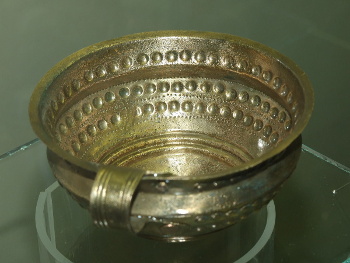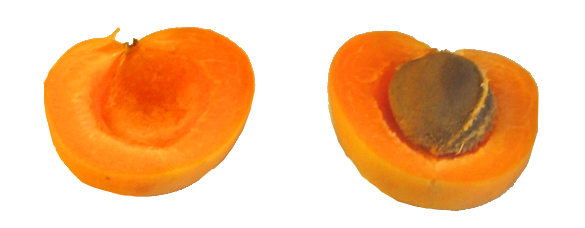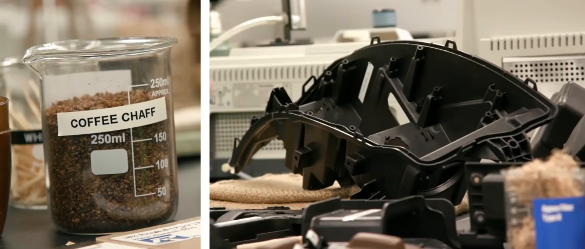Natural Materials
February 3, 2020
It's interesting how the
Ages of Man are defined by the
materials used in those times. We have the
Stone Age in which
stone was man's principal material during a period of about three million years until the advent of
metalworking.
Copper was used in the
Chalcolithic Age, and this was closely followed by the
Bronze Age after the discovery that adding
tin to copper produced an
alloy of greater
strength and
hardness. Bronze exists over a range of tin
concentrations, but modern
bronze generally contains about 10% tin.

Late Bronze Age bronze cup in the National Museum, Prague
(Photograph by Kozuch, via Wikimedia Commons.)
The Bronze age was followed by the
Iron Age that began in the
12th century BC. While iron is an
abundant element, it's hard to
separate from its compounds, and the
melting point of iron, 1,538
°C (2,800
°F) is much higher than that of copper, 1,085 °C (1,985 °F). The Iron Age is the last
Age defined by
archaeologists, and we still use a lot of iron, today. However, the present day could be considered to be the
Concrete Age for reasons I explained in a
previous article (Roman Concrete, August 7, 2017).
All
technologies develop from the simple to the complex, an example being the
evolution of
aviation from the
Wright Brothers' aircraft to the
Lockheed Martin F-35, and man's use of materials shows this trend. Stone, of course, is quite abundant, and stone of desired properties for
stone knives and spear heads can be found at your
feet.
Gold and
silver can be found as
free metal in
mineral deposits, so these were the first useful
metals.
Archaeologists, however, don't have a
Gold Age or a
Silver Age in their
chronology.

The seventh or eighth century BC Greek poet, Hesiod, wrote about the ages of man in his "Works and Days." This was a short, 800 line poem, written to his brother as a guide to how he should live his life. Hesiod included a Golden Age and a Silver age in his Five Ages of Man, and he believed that the progression of ages from gold to iron indicated a decline of civilization. This fragment from the Works and Days is translated, "For now truly is a race of iron, and men never rest from labor and sorrow by day, and from perishing by night; and the gods shall lay sore trouble upon them." [Hesiod, Works and Days, ll. 176-178]. (Via Project Perseus))
The expression, "
cheap as dirt," might be considered an
oxymoron, today, when a
pound of
potting soil might cost a
dollar. However,
clay has been used for making
pottery, for making
bricks, as a
building material, and for
writing tablets for sixteen or more
centuries. Clays are
hydrated phyllosilicate minerals that are
plastic when mixed with
water, but are firm upon drying and hard when
fired in a
kiln. One modern use of clay is as a
coating for
paper to produce
gloss.
Metals come to us from nature in mineral ores, but another
mineral source for modern materials is
mineral oil, the
generic term for
petroleum distillates. The principal
non-fuel product of
petroleum is
plastic, and plastic is such a versatile material that it's a
major pollutant, especially as a source of
ocean pollution. Plastic
decomposes very slowly in the
environment, but this decomposition is aided by the addition of materials such as
starch or a
protein derivative of
soybeans that produces a
biodegradable plastic.

Ford exhibited a "Soybean Car" (centered in this image) in 1941 at a time when steel was expected to become in short supply because of World War II.
The body was the only component containing soy, and it needed to be about a quarter of an inch thick to exhibit sufficient strength.
This concept car was never developed. (Still image from a YouTube video by Aleksei Germanovich.)
As a consequence of many online videos of dipping things into liquid nitrogen and smashing them to bits, it's common knowledge that most materials become brittle when cooled to very low temperatures.
Gaskets are needed for many low temperature mechanical systems, such as
liquefaction plants for producing
liquid helium. Fortunately,
leather maintains its
flexibility at
low temperatures, so it's often used in such applications. The principal component of leather is
collagen, a material having amino acids that combine to form
triple helical fibers.
Discarded portions of some food products are also useful materials.
Nutshells, especially
walnut shells, are used as a
sandblasting abrasive in many applications since they are
abrasive, but soft enough to not cause damage to the
polished piece. They are also
non-toxic, they don't produce
mineral dust, and they are
biodegradable.
Pulverized apricot pits are used as an abrasive for
deflashing plastic integrated circuit packages.

Apricot halves, showing the pit. Turkey is the foremost apricot producing country in the world. Its 2017 annual production was 985,000 metric tons, which is nearly 25% of the world's production. This far outstrips the United States 2017 annual production of 37,790 metric tons. (Modified Wikimedia Commons image by Maksim.)
Ford, the
innovator of the Soybean Car, has been using other
natural materials, such as
tree cellulose, in its products. In a recent innovation, it's putting
coffee bean chaff, the coffee bean skin that's a
by-product of the
coffee bean roasting process, into the plastic material from which
headlamp housings are made. Ford has partnered with
fast food giant,
McDonald's, which doesn't roast its own bean but has asked its contract coffee bean roasters to work with Ford.[1-4]
One motivation for incorporating natural materials into products is
consumer desire for reducing
carbon emission and plastic pollution, and Ford has been using waste from
wheat,
tomato,
coconut, and other
plants to satisfy its material needs.[1] Ford headlamp housing are made with
talc addition to plastic, but using coffee bean chaff instead of talc allows substitution of a
renewable material for a mineral.[1] Coffee chaff is widely available, so Ford decided to try using this waste material, since it's been
experimenting with
organic materials for quite some time.[1]
Ford teamed with McDonald's since the fast food company generates 62 million pounds of coffee bean chaff annually in the
contiguous United States, with a portion presently becoming
garden mulch.[3] Coffee bean chaff is quite heat-resistant, and it allows fabrication of parts that are 20% lighter.[2-3] The Ford process involves a first step in which the chaff is heated to high
temperature in a
low oxygen environment. Using the chaff requires 25% less
energy during the
molding process.[2-3]

Laboratory sample of coffee bean chaff, and a headlamp housings containing this material. (Still images from a Ford YouTube video.[4])
As a side benefit, the chaff-plastic
composite material smells like coffee during melting, a nice alternative to the typical
odors involved in plastic molding.[2] While the headlamp housings are its first coffee bean chaff material, Ford intends to use it for other components, also.[2]
References:
- Danielle Wiener-Bronner, "Ford is turning McDonald's coffee waste into headlights," CNN, December 4, 2019. Also at The Pittsburgh Post-Gazette, December 7, 2019.
- Chris Bruce, "Ford Is Turning McDonald's Coffee Waste Into Car Parts," Motor 1, , December 4, 2019.
- Mariella Moon, "Ford will turn McDonald's used coffee bean husks into car parts," Engadget, December 4, 2019.
- Ford and McDonald’s: Executives In Cars Talking Coffee, Ford Motor Company YouTube Video, December 4, 2019.
Linked Keywords: Ages of Man; material; Stone Age; rock (geology); stone; metalworking; copper; Chalcolithic Age; Bronze Age; tin; alloy; strength of materials; hardness; concentration; bronze; cup; National Museum, Prague; Kozuch; Iron Age; 12th century BC; abundances of the elements; ancient iron production; melting point; Celsius; °C; Fahrenheit; °F; archaeology; archaeologist; Concrete Age; technology; evolution (term); aviation; Wright Brothers; Wright Flyer; aircraft; Lockheed Martin F-35; stone tool; stone knives and spear heads; foot; feet; gold; silver; gold nugget; free metal; lode; mineral deposit; metal; chronology; 7th century BC; 8th century BC; Greek; poet; Hesiod; Ages of Man; Works and Days; poetry; poem; brother; societal collapse; decline of civilization; translation; translate; Project Perseus; cheap as dirt; oxymoron; pound (mass); potting soil; dollar; clay; historical and modern uses; pottery; brick; adobe; building material; clay tablet; writing tablet; century; centuries; hydrate; hydrated; silicate mineral; phyllosilicate; mineral; plasticity (physics); water; pottery firing; fired; kiln; coated paper; coating; paper; gloss (optics); mineral oil; generic term; petroleum; distillation; distillate; fuel; plastic; plastic pollution; pollutant; marine debris; ocean pollution; chemical decomposition; decompose; biophysical environment; starch; protein; soybean; biodegradable plastic; Ford Motor Company; Soybean Car; steel; World War II; inch; ultimate tensile strength; YouTube video; gasket; liquefaction of gases; liquefaction plant; liquid helium; leather; deflection (engineering); flexibility; cryogenics; low temperature; collagen; collagen helix; triple helix; food waste; discarded portions of some food products; nutshell; walnut shell; abrasive blasting; sandblasting; abrasive; polishing; polish; toxicity; non-toxic; mineral dust; biodegradation; biodegradable; pulverizer; pulverize; apricot; seed; pit; flash (manufacturing); deflashing; epoxy; integrated circuit package; Turkey; apricot production; metric ton; United States; Wikimedia Commons; Maksim; innovation; innovator; natural material; tree; cellulose; coffee bean; chaff; by-product; coffee bean roasting process; headlamp housing; fast food restaurant; McDonald's; consumer; greenhouse gas; carbon emission; wheat; tomato; coconut; plant; talc; renewable resource; renewable material; experiment; experimenting; organic compound; contiguous United States; garden; mulch; temperature; hypoxia (environmental); low oxygen environment; energy; molding process; laboratory; sample (material); composite material; odor; smell.